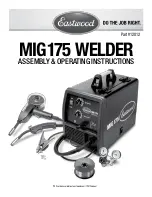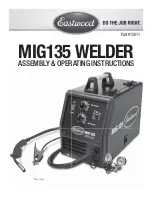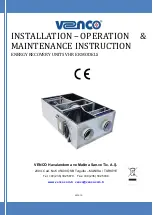
OperatiOn
HPR130XD Auto Gas –
806330 Revision 2
4-23
Additional improvements
Additional improvements
Some of these improvements involve trade-offs, as described.
Piercing
The pierce delay should allow sufficient time to penetrate the full thickness of the material, but not so long that it allows
the arc to “wander” while trying to find the edge of a large pierce hole. As consumables wear, this delay time may need
to be increased. Pierce delay times given in the cut charts are based on average delay times throughout the life of the
consumables.
Using the “pierce complete” signal during piercing maintains the shield-gas pressure at the higher preflow pressure,
which provides additional protection for the consumables (for example: 30 amp O
2
/O
2
and 50 amp O
2
/O
2
processes).
The pierce complete signal must be turned off for processes with shield gas preflow pressures that are lower than the
cutflow pressures (for example: 600 amp and 800 amp processes).
When piercing materials close to the maximum thickness for a specific process, there are several important factors to
consider:
• Allow a lead-in distance that is about the same as the thickness of the material being pierced. 50 mm (2 in)
material requires a 50 mm lead-in.
• To avoid damage to the shield from the build up of molten material created by the pierce, do not allow the torch
to descend to cut height until it has cleared the puddle of molten material.
• Different material chemistries can have an adverse effect on the pierce capability of the system. In particular,
high-strength steel and steel with a high manganese or silicon content can reduce the maximum pierce
capability. Hypertherm calculates mild steel pierce parameters with certified A-36 plate.
• If the system has difficulty piercing a specific material or thickness, increasing the shield preflow pressure can
help in some cases.
Trade-off: This may reduce starting reliability.
• Using a “moving pierce” or “flying pierce” (starting torch motion immediately after transfer and during the pierce
process) can extend the piercing capability of the system in some cases. Because this can be a complex
process that can damage the torch, lifter, or other components, an edge start is recommended unless the
operator is experienced with this technique.
How to increase cutting speed
• Decrease the torch-to-work distance.
Trade-off: This will increase the negative cut angle.
Note: The torch must not touch the workpiece while piercing or cutting.
Содержание HyPerformance HPR130XD
Страница 1: ...HyPerformance Plasma HPR130XD Auto gas Instruction manual 806330 Revision 3 ...
Страница 16: ...Table of Contents viii HPR130XD Auto Gas 806330 ...
Страница 26: ...Specifications 2 2 HPR130XD Auto Gas 806330 ...
Страница 38: ...Specifications 2 14 HPR130XD Auto Gas 806330 ...
Страница 48: ...Installation 3 10 HPR130XD Auto Gas 806330 ...
Страница 51: ...Installation HPR130XD Auto Gas 806330 3 13 LHF mounting Horizontal RHF mounting Vertical RHF mounting ...
Страница 59: ...Installation HPR130XD Auto Gas 806330 3 21 1X1 J103 J300 Female Male 5 6 5 6 3X1 3X2 3X3 3X4 ...
Страница 61: ...Installation HPR130XD Auto Gas 806330 3 23 7 Caution Never use PTFE tape on any joint preparation ...
Страница 94: ...Installation 3 56 HPR130XD Auto Gas 806330 ...
Страница 101: ...Operation HPR130XD Auto Gas 806330 Revision 2 4 7 Diagnostics screen ...
Страница 102: ...Operation 4 8 HPR130XD Auto Gas 806330 Revision 2 Test screen ...
Страница 103: ...Operation HPR130XD Auto Gas 806330 Revision 2 4 9 Cut chart screen ...
Страница 152: ...Operation 4 58 HPR130XD Auto Gas 806330 Revision 2 ...
Страница 236: ...7 4 HPR130XD Auto Gas 806330 Discrete output functionality ...
Страница 294: ...Appendix B CNC Interface Protocol b 28 HPR130XD Auto Gas 806330 Revision 1 ...
Страница 302: ...4 HPR130XD Auto Gas 806330 ...
















































